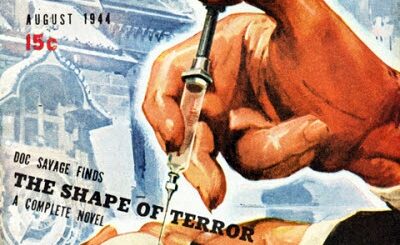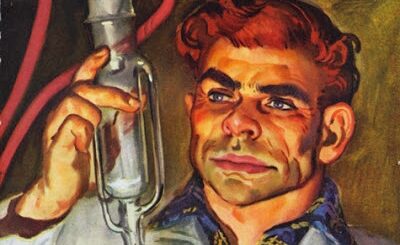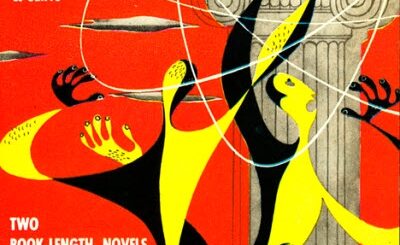Pirate of the Pacific
Not ships but nations are the prey of the sinister Oriental mastermind, Tom Too. Only Doc Savage and his daring crew stand a chance of saving the world from this figure of evil and his lethal legions. On land and sea, in the weirdest corners of the wide world, Doc and his friends plunge into their wildest adventure — against their most dangerous foe!






Can’t go too far wrong with a “Doc in Asia” story. Put this one in the top 50%.
Not one of my favourites. I like the oriental pirates and Tom Too is a great name for a villain but the pacing is just off with this one. I’d say average at best.
For me, this was a good, solid Doc adventure. No big exciting mystery or anything, but the action is almost non stop. Not in my top 10, but well worth reading. I’d rather read this 100 times than read THE SPOOK OF GRANDPA EBEN, or any of the stories in Omnibus 3, just once. (a little off the subject, I know, but I was so bored and dissapointed by Omnibus 3… because I just started buying the Omnibus books, and I hope #3 is not typical of the Omnibus stories… because it is garbage.)
The first time I read it I didn’t care for it much, but rereading it years later I found it was actually a decent enough tale. Not superb by Doc standards but still entertaining.
I agree with several things said above about Pirate of the Pacific: the pacing is wrong; the action is non-stop; Tom Too is a memorable villian; it still entertains after half a century.
The “still entertains” after all this time aspect is something I want to touch on in more detail. The key to longevity for many of Doc Savage’s tales is not that they are exciting, heroic, or cool, but that they also are among those very rare books that extrapolate plausibly a future ahead of its time. Verne and Wells often did this, for example, hence their works remain fresh in the century following their creation. The Island of Dr. Moreau, for example, chronicled animal-human breeding experiments — or to phrase it another way, as we witness just now becoming possible, it relates mutagenetic manipulations. In numerous Savage adventures he touched on things that are still relevant today: Mideast dictators launching a third world war; or Indian-Pakistani wars and biochemical weapons of mass destruction; etc. They resonate largely because they sound as if they are still on the front page. Furthermore his inventions, weapons, planes, labs, theories, and even villians often predicted the future. An uzi is a good descendent of a machine-pistol. Kevlar makes a good, lightweight bulletproof undergarment.
Pirate of the Pacific is one of this type of tales. The book lacked some finesse, with pacing at times slow and at other times rushed, but its message or the theory behind Tom Too’s non-technical threat is extremely valid, frightening, and in play today. I’ve discussed in on-group before, but will recap some. On p 50 of the Bantam edition it is revealed that Tom Too’s power plan is simple: a secret, massive, relatively bloodless coup of the Philippines (oops I mean Luzon Union) via manipulation of perceptions and the people. The outright removal of current leadership will be a combo of coercion, threat, and assassination, though to the people in general this is twisted inside out so he will ride into town as the hero saving them all, protecting the country, defending democracy and their security. It is the patriot’s trumpcard. This is exactly what has happened and is still happening over and over in the world today. Nation’s are destabilized (often even by coups of “legitimate intent” by organizations such as the CIA)and populations mislead into wars or disasters by Orwellian techniques of societal manipulation in today’s political strategies. Doc calls Tom Too’s actions the modern equivolent of piracy, though of nations not ships (p 89). The book is pretty clear on what is actually occurring and at stake, and is like a modern blackops playbook. It is very realistic in a Machiavellian world. The saddest and most shocking part of all, though, is that Doc makes a deal with the devil to help prop up the cabal of dictatorial rulers and businessmen controlling the nation currently. They are simply the lesser of two evils. So he saves their hides and defeats the Too evil menace.
Switching gears (because of space) I want to note a few interesting moments in the book for Savage fans. 1) this is one of the early books of the series still immediately connected to its predicessor, so it has a lot of continuity. It ends The Polar Treasure and begins with the press eagerly awaiting the return to Manhattan of the Helldiver sub, now manned by Doc and crew as the sole surivors of an ill-fated Arctic mission. Doc shuns publicity and alludes them all neatly, though somehow the Tom Tooan henchmen are there knowingly and attack him full-bore with airplanes, bombs, guns, etc. Doc and guys go literally from the Artic to the Pacific in a nonstop battle. No rest ever for these guys. 2) Doc has a television wristwatch. Is this prior to Dick Tracy or after? 3) Doc is said to weigh far less than Monk and Renny, at just barely 200 pounds. That surprised me, as elsewhere in the series his immense weight or density is often mentioned when badguys try to carry him. Usually takes a whole squad of grunting guys. That doesn’t sound 200-ish to me. Especially with his build if he is far taller than them all. 4) On this same topic, there is a weird mention that Renny’s fists alone weigh about 50 pounds. What the hell? In another scene his fists are said to be the size of four normal fists bunched together! Elsewhere Doc is about to knock out the panels on a heavy wood door but then thinks better about it to preserve his surgeon’s hands and so calls Renny in to do it for him. Smart choice if the man has 4X fists that weigh fifty pounds. That like a wrecking ball arm. 5) In this book the entire polar treasure from the previous tale is said to be used on redesigning and expanding the Crime College in upstate NY!!! So much for charities. 6) Speaking of charities, there is one of those nice touches at the end where the Luzon Union, to acknowledge their debt, builds a Savage Memorial Hospital. I wondered if this is the only one of his many established hospitals in the world actually named after him? What was the one in Chile named, before the blue meteor interrupted the grand opening? Just curious. 7) Doc’s car is a roofless gray 16-cylinder roadster topping out over 150 mph. Wow. So much for discreet. 8) It says that right berside Doc’s office, due to the Depression, there are empty offices on the same floor. The criminals break into one of these and then bore throigh the wall into his reception room. !!!!!!!!! OK. (Must be one of those quirks the writers/editors worked out and later dropped.) 9) Doc’s grenades are said to be big and iron. Guess he hasn’t streamlined them yet into the little silver balls. 10) Finally, as said, this is early Doc, so he is invincible, so fast people cannot even see him move, able to do amazing feats of strength that are truly superhuman, etc. But also this means that this is one of those books where his aids are just bumping guys off right and left without remorse. In one brutal scene that is the model for all Wild West shootouts, Long Tom outdraws a villian throwing a knife into his pal and caps him right between the eyes. Cops are there but do nothing because they hold police commissions. (p 36) Ahhh, the good old days when you didn’t have all those pesky laws to hinder your work.
Anyway, since there is an endless supply of nifty details Ican’t cover, I’ll close by saying maybe the book sound be given more credit, in a different light. Ignoring the “early years” extravagence in action, perhaps the meat lies in the hardcore reality of subversive global politics portrayed in this book.
Thomas Fortenberry
This Bantam book has one of James Bama’s very best covers. I remember looking at it for hours. The story is quite good, but not one of the best. There’s a great escape from a sinking ship that I haven’t seen anywhere else and I was awestruck by Doc’s boldness in suggesting it. But, then, that’s Doc: always thinking one step ahead of a fifteen-year-old reader.
I enjoyed the first two-thirds of this one, but got a little weary towards the end. There’s not much in the way of a plot or mystery, just the usual runaround Doc action. I like action as much as the next Doc fan but it helps when Dent pauses once in a while to fill in some background. He doesn’t do much of that here; “local color” is limited to a lot of ridiculous characterizations of “slant-eyed Mongol hordes” and “half-castes”.
Still, this is a much better story than “Quest of the Spider”. Dent is starting to use fewer exclamation points in this fifth book, and there aren’t as many awkward word choices.
My biggest complaint is that Monk, Johnny, and Long Tom are “off stage” for most of the book. Doc spends most of his time with Renny. I know this guy is supposed to be a world-class engineer, but he doesn’t act very bright most of the time. (Note that Doc has reinforced the door to the 86th Floor to stop Renny from smashing his fist through it. Hopefully he sent Renny a bill; the Mayans shouldn’t have to pay for stuff like that.
I found this read to be a little off pace at times. I enjoyed the first half of the story, especially how it begins on the heels of The Polar Treasure, even going as far as referencing how Doc and the boys put Victor Vail and his daughter (both of whom remain nameless in this novel) onto a passing liner to avoid the press eagerly awaiting the arrival of the Helldiver. The latter scenes, while action packed, seemed to drag at times.
I don’t understand all the Doc fans who give this book a mediocre review. I totally disagree! “Pirate of the Pacific” is one of the very best of the early Docs and deserves a place in the all-time top ten. The pacing is NOT off. In fact, from the terrific opening scenes of Mongols dive bombing the Helldiver to the explosive climax on Shark Head Island, Dent keeps the action and plot charging along at a perfect clip. Yet he still has time to put in the wonderful little flourishes that make it a Dent story: the pigeon with the microphone in its tail feathers, Doc’s TV wristwatch, the escape from the Malay Queen. Heck, I was even surprised at the identity of the villain (for a change).
For all you newer Doc fans, don’t skip over this one. Trust me, you’ll love it.